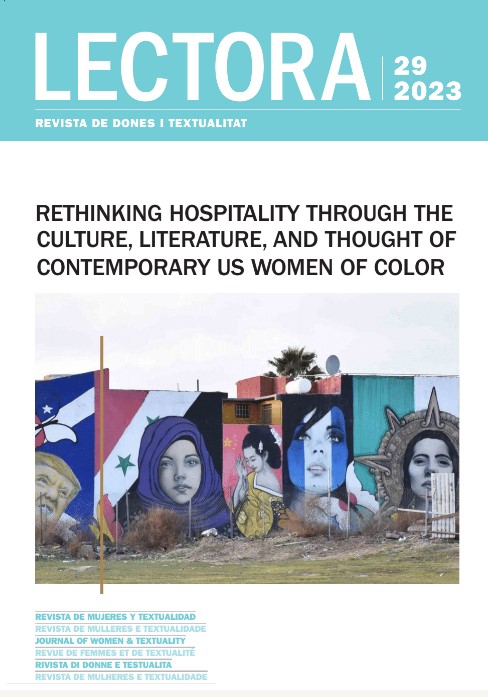Sobre la noción de mímesis en la apuesta política y metodológica de Luce Irigaray
DOI:
https://doi.org/10.1344/Lectora2023.29.12Keywords:
mimesis, laughter, sexual difference, psychoanalysis, feminismAbstract
In the philosophical, psychoanalytical, and linguistic framework of Luce Irigaray’s project, the notion of mimesis holds a fundamental place. Exhibited by the author as a methodological research resource and as a political praxis, it is a strategy that seeks to dislocate the discursive order that sustains our Western culture, eminently phallocentric and patriarchal. This antidote against uniformity and the original-copy logic that governs our tradition is deployed in her work by virtue of three dimensions (Schor, 1993): masquerade, sly mimesis, and joyful reappropriation or positive difference. In what follows, and articulating these three senses, I am interested in mapping this notion by virtue of some moments of Irigaray’s project, attending to its genealogical, ethical, and political aspects. Irigaray’s wager on the transformative and creative sense of the resource of mimesis, as opposed to the sense of specular imitation that runs through our single-subject tradition, reflects the double task of his endeavour: the profound critique of the foundations of the Western tradition of thought and the need to generate the conditions for transforming an entire culture.
References
Amigot, Patricia (2007), "Joan Rivière, la mascarada y la disolución de la esencia femenina", Athenea digital, 11: 209-18.
Cassin, Barbara, Emily Apter, Jacques Lezra y Michael Wood (2014), Dictionary of Untranslatables: A Philosophical Lexicon, Princeton, Princeton UP.
Doane, Mary Ann (1987), The Desire to Desire: The Woman’s Film of the 1940s, Indianapolis, Indiana UP.
Federici, Silvia (2022), Ir más allá de la piel. Repensar, rehacer y reivindicar el cuerpo en el capitalismo contemporáneo, Madrid, Traficante de sueños.
Garrido Gallardo, Miguel Ángel (2015), DETLI. Diccionario español de términos literarios internacionales.
Grosz, Elizabeth (1989), Sexual Subversions: Three French Feminists, Melbourne, Allen & Unwin.
―(2012), "The Nature of Sexual Difference: Irigaray and Darwin", Angelaki: Journal of Theoretical Humanities, 17: 69-93.
Grosz, Elizabeth y Luce Irigaray (2008), "Sexuate Identities as Global Beings. Conversations between Luce Irigaray and Elizabeth Grosz", Conversations, Luce Irigaray, Londres, Continuum: 124-38.
Irigaray, Luce (1974), Speculum: de l’autre femme, París, Minuit.
―(1977), Ce sexe qui n’en est pas un, París, Minuit.
―(1994), Amo a ti: bosquejo de una felicidad en la historia, Barcelona, Icaria.
―(2007), Espéculo de la otra mujer, Madrid, Akal.
―(2009), Ese sexo que no es uno, Barcelona, Akal. [1997]
―(2010), Ética de la diferencia sexual, Castellón, Elago.
Mortensen, Ellen (1995), The Feminine and Nihilism. Luce Irigaray with Nietzsche and Heidegger, Copenhague, Scandinavian UP.
Ricoeur, Paul (1982), "Mimèsis et représentation", Actes du XVIIIe Congrès des sociétés de philosophie de langue française, Estrasburgo, Université des Sciences Humaines de Strasbourg, Faculté de Philosophie: 51-63.
―(2008), Hermenéutica y acción, Buenos Aires, Prometeo.
Rivière, Joan (1991), "Womanliness as a masquerade", The Inner World and Joan Rivière: Collected Works, Joan Rivière y Athol Hughes (eds.), Nueva York, Karnac Books: 90-102. [1929]
Roberts, Laura (2019), Irigaray and Politics: A Critical Introduction, Edimburgo, Edinburgh UP.
Santa Cruz, María Isabel (1986), "Eikós lógos y diánoia en Platón", Revista de filosofía y teoría política, 26/27: 180-4.
Schor, Naomi (1993), "Cet essentialisme qui n’(en) est pas un", Futur antérieur: "Supplément: Féminismes au présent". París, L’Harmattan, 85-109.
Söderbäck, Fanny (2019), Revolutionary Time: On Time and Difference in Kristeva and Irigaray, Albany, State University of New York Press, 2019.
Suñol, Viviana (2008), Mímesis en Aristóteles. Reconsideración de su significado y su función en el Corpus Aristotelicum, Tesis doctoral, La Plata, Universidad Nacional de La Plata, 28/11/2008.
Vernant, Jean-Pierre (1975), "Image et apparence dans la théorie platonicienne de la mimesis", Journal de psychologie normale et pathologique, 2: 133-60.
Downloads
Published
How to Cite
Issue
Section
License
Copyright (c) 2023 Andrea Ugalde Guajardo

This work is licensed under a Creative Commons Attribution-NonCommercial-NoDerivatives 4.0 International License.
The Author retains ownership of the copyright in this article and grants Lectora: revista de dones i textualitat the rights to print publication of the Article. The work will be available under a Creative Commons Attribution-Noncommercial-No Derivative Works license, by which the article must be credited to the Author and the Journal be credited as first place of publication.
The Author is free to enter in seperate, additional contractual agreements for the non-exclusive distribution of the work as published in this journal (such as institutional repositories or a book), as long as the original publication in Lectora is credited.
The Author is encouraged to post the work online (eg in institutional or thematic repositories, or in their website), as it can lead to productive exchanges as well as to a greater citation of the published work (see The Effect of Open Access).



